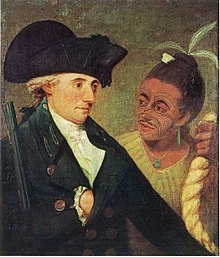Charles Clerke: Difference between revisions
Victuallers (talk | contribs) ref |
No edit summary |
||
| Line 17: | Line 17: | ||
Clerke took command of the expedition and of HMS ''Resolution'', when Cook was killed in a skirmish with [[Hawaii]]ans on February 14, 1779. |
Clerke took command of the expedition and of HMS ''Resolution'', when Cook was killed in a skirmish with [[Hawaii]]ans on February 14, 1779. |
||
Clerke continued the expedition's exploration of the Northern Pacific coast, searching for a navigable [[Northwest Passage]]. The expedition then proceeded to the Pacific coast of Siberia. [[James King (Royal Navy officer)|James King]], one of his subordinates, wrote that Clerke's illness had reduced him to skeletal thinness. Clerke died en route to [[Kamchatka]] from tuberculosis. Clerke was buried in Kamchatka on August 29, 1779. In 1913, a small [[obelisk]] was erected by the [[British Admiralty]] in his honour at [[Petropavlovsk-Kamchatskiy]], Russia, with an inscription in English.<ref>''The Captain Cook Encyclopædia'', p. 62. John Robson. Random House Australia. ISBN 0-7593-1011-4.</ref> |
Clerke continued the expedition's exploration of the Northern Pacific coast, searching for a navigable [[Northwest Passage]]. The expedition then proceeded to the Pacific coast of Siberia. [[James King (Royal Navy officer)|James King]], one of his subordinates, wrote that Clerke's illness had reduced him to skeletal thinness. Clerke died en route to [[Kamchatka]] from tuberculosis. Clerke was buried in Kamchatka on August 29, 1779. In 1913, a small [[obelisk]] was erected by the [[British Admiralty]] in his honour at [[Petropavlovsk-Kamchatskiy]], Russia, with an inscription in English.<ref>''The Captain Cook Encyclopædia'', p. 62. John Robson. Random House Australia. ISBN 0-7593-1011-4.</ref><ref>http://www.fotopetropavlovsk.ru/2010/08/10/monument-charles-clerke/</ref><ref>http://vsam1.jino.ru/semenov/content/view/33/47/</ref> |
||
Clerke's second in command, [[John Gore (seaman)|John Gore]], took command and took the expedition home to Britain. |
Clerke's second in command, [[John Gore (seaman)|John Gore]], took command and took the expedition home to Britain. |
||
Revision as of 13:02, 2 September 2010

Captain Charles Clerke RN (August 22, 1741 – August 1779) was an officer in the Royal Navy who sailed on four voyages of exploration.
Clerke started studying at the Royal Naval Academy in Portsmouth when he was 13. During the Seven Years' War he served aboard HMS Dorsetshire and HMS Bellona. He was in the mizzen-top of HMS Bellona when the mast was shot away in 1761 and he became the only survivor of those who consequently fell overboard.[1]
In June 1764 he joined Captain John Byron, aboard HMS Dolphin, on Byron's expedition to explore the Pacific.
The Dolphin returned in May 1766. Its circumnavigation of 22 months was the shortest up to that point. Upon his return Clerke published an account of encountering Patagonian giants, was probably a hoax which the Dictionary of Canadian Biography attributed to his high spirits.[2]
Clerke's last three voyages were all under the command of Captain James Cook.
Clerke started the first voyage aboard HM Bark Endeavour (1768–1771) as a master's mate. Cook promoted him to acting lieutenant in 1771. Clerke was HMS Resolution's second lieutenant on Cook's second voyage (1772–1775).
While ashore between Cook's 2nd and 3rd voyages Clerke agreed to serve time in the Fleet debtor's prison for a debt one of his brothers, Sir John Clerke had incurred. While in debtor's prison he was infected with the tuberculosis that eventually killed him.[3]
Clerke took command of the expedition and of HMS Resolution, when Cook was killed in a skirmish with Hawaiians on February 14, 1779.
Clerke continued the expedition's exploration of the Northern Pacific coast, searching for a navigable Northwest Passage. The expedition then proceeded to the Pacific coast of Siberia. James King, one of his subordinates, wrote that Clerke's illness had reduced him to skeletal thinness. Clerke died en route to Kamchatka from tuberculosis. Clerke was buried in Kamchatka on August 29, 1779. In 1913, a small obelisk was erected by the British Admiralty in his honour at Petropavlovsk-Kamchatskiy, Russia, with an inscription in English.[4][5][6]
Clerke's second in command, John Gore, took command and took the expedition home to Britain.
Footnotes
- ^ The Captain Cook Encyclopædia, p. 61. John Robson. Random House Australia. ISBN 0-7593-1011-4.
- ^ biography from the Dictionary of Canadian Biography
- ^ The Captain Cook Encyclopædia, p. 62. John Robson. Random House Australia. ISBN 0-7593-1011-4.
- ^ The Captain Cook Encyclopædia, p. 62. John Robson. Random House Australia. ISBN 0-7593-1011-4.
- ^ http://www.fotopetropavlovsk.ru/2010/08/10/monument-charles-clerke/
- ^ http://vsam1.jino.ru/semenov/content/view/33/47/
External links
- Charles Clerke article from the German version of the Wikipedia English translation
- HMS Discovery, Ships of the World: An Historical Encyclopedia
- biography
- (second) last will and testament
- 4 letters from Clerke to Sir Joseph Banks
- More information on Charles Clerke from the New Zealand Electronic Text Centre]
